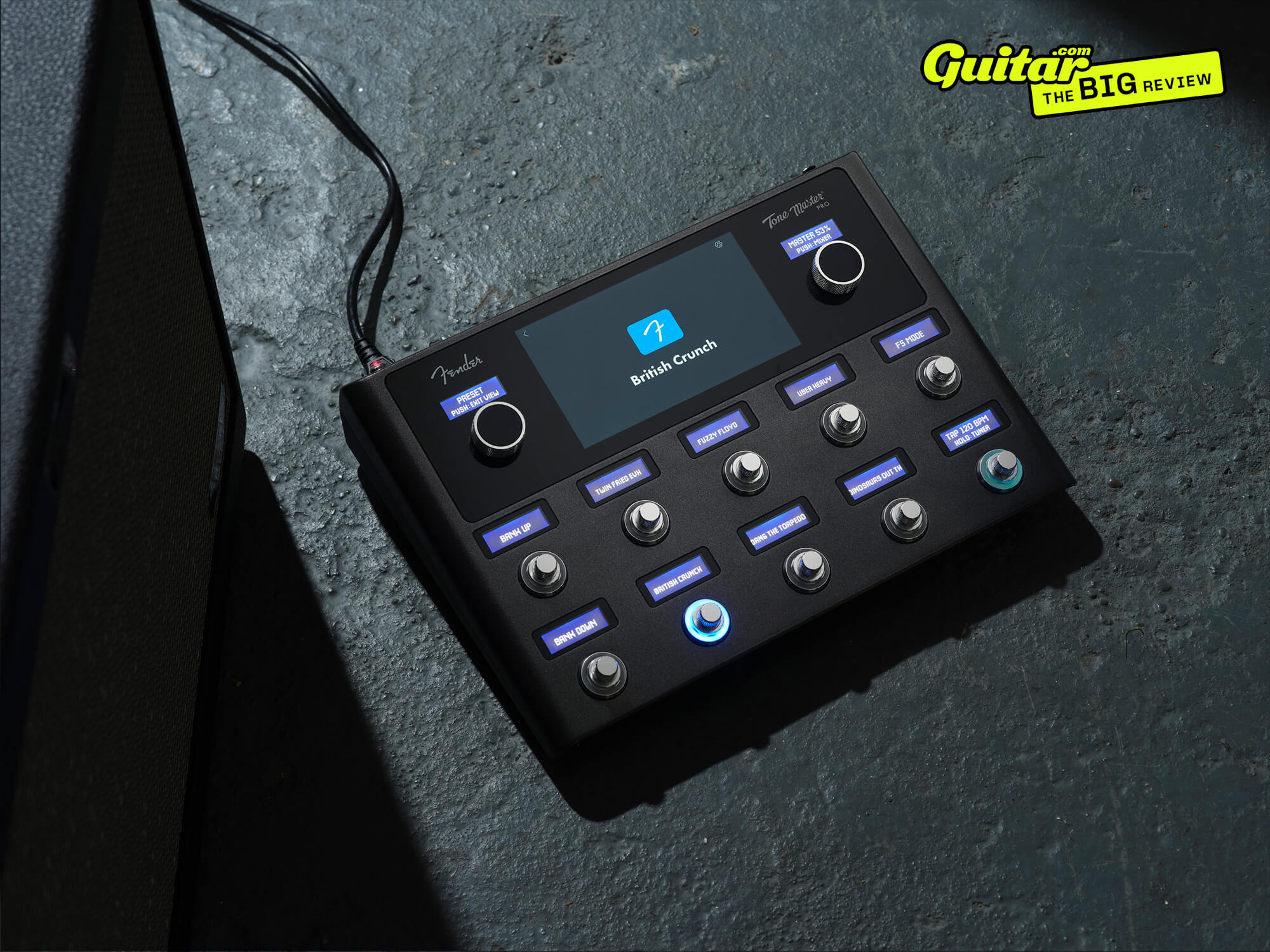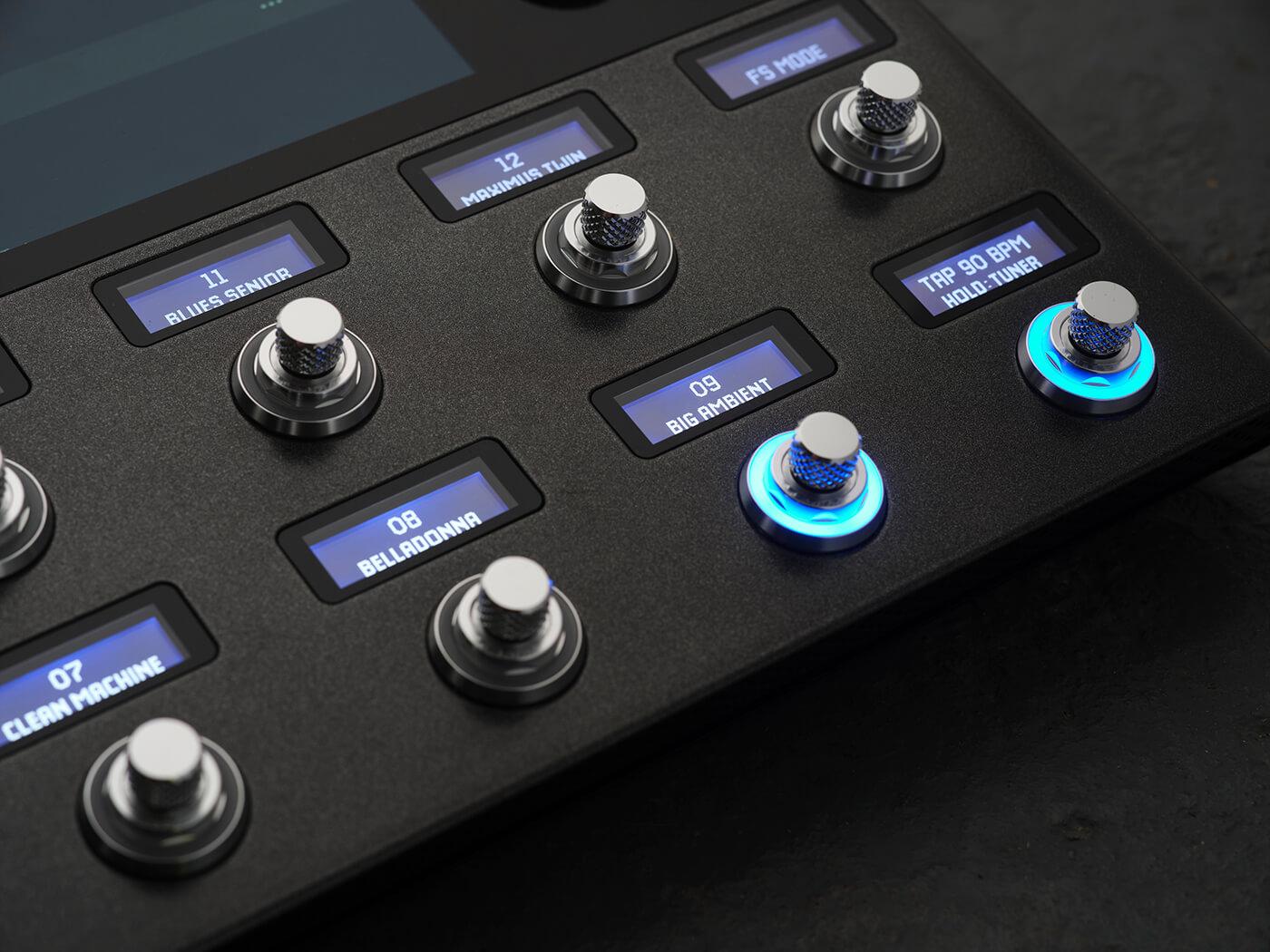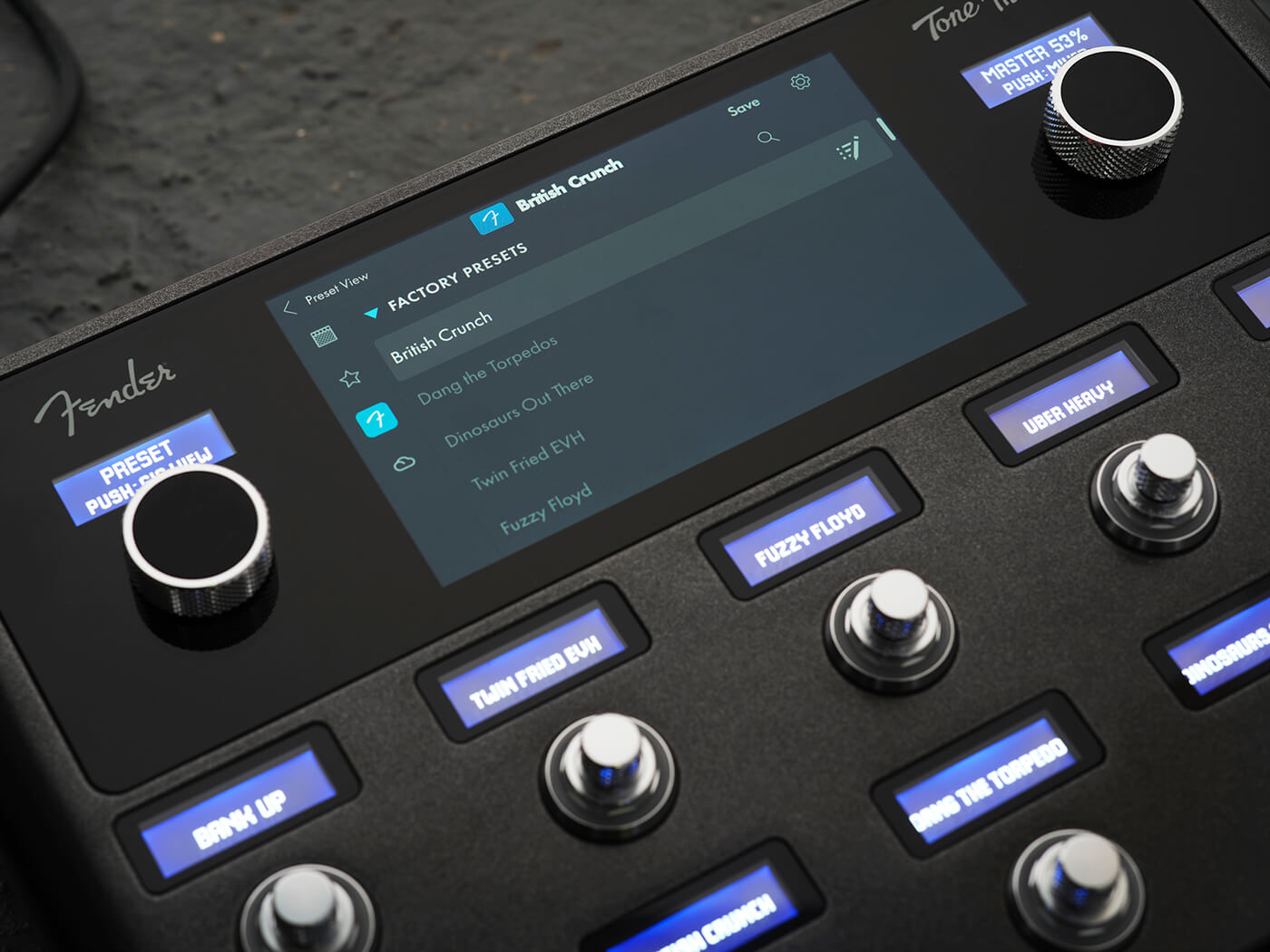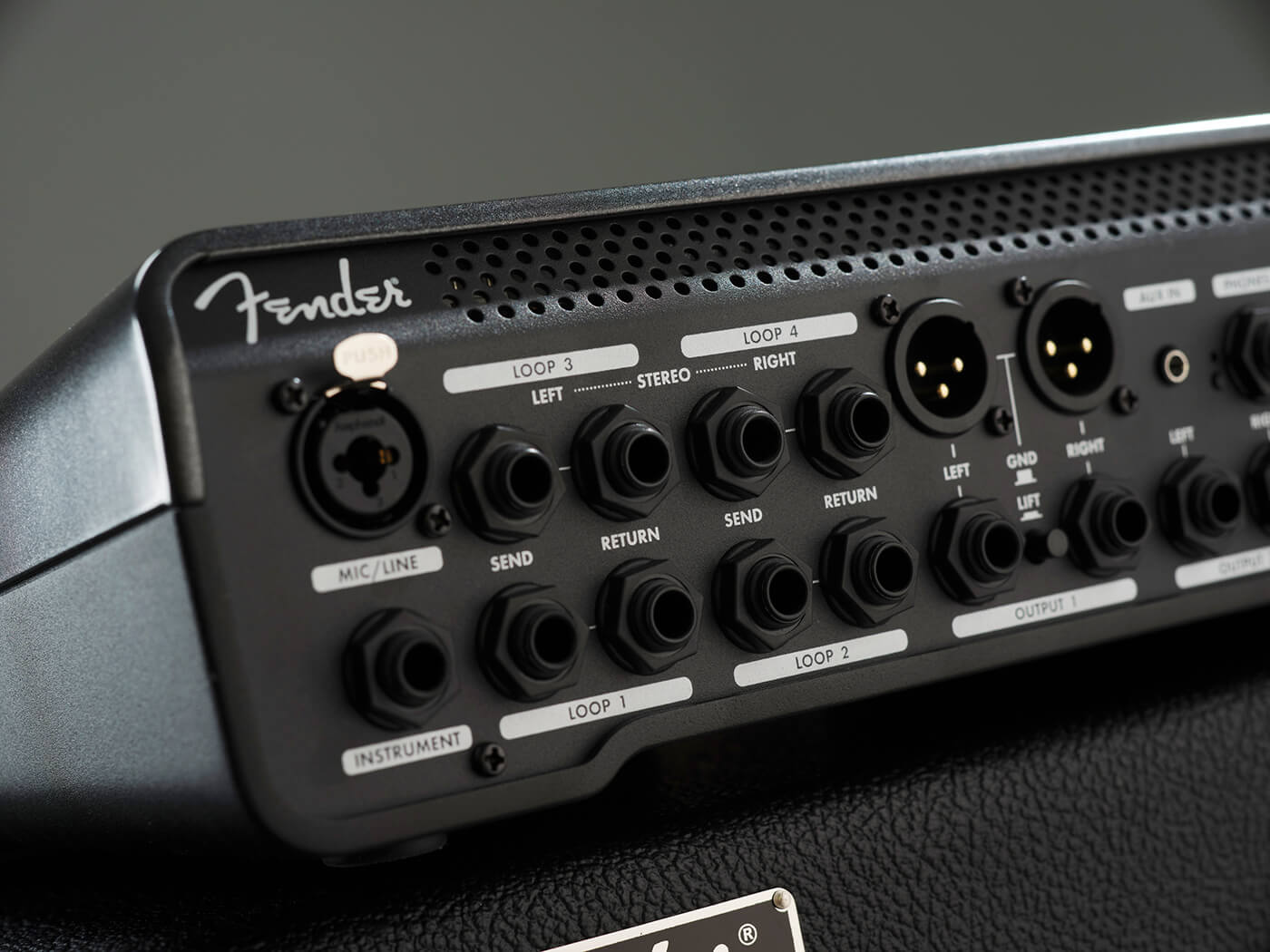Fender Tone Master Pro review: a very Fender floor modeller
Fender’s leveraged its Tone Master Tech for an entry into the familiar floor modeller format… can it go toe-to-toe with stiff competition from Neural, Helix and Kemper?

Image: Adam Gasson
Review Overview
Our rating
8
Our verdict
$1,699 / £1,649, www.fender.com
You probably don’t need me to tell you that when Fender announced the Tone Master Pro a few weeks ago the guitar internet promptly lost its shit – after all, Fender had never before ventured into the multi-effects world, and this one was going big aiming a product squarely down the ‘modern flagship floor modeller’ aisle. But should we have been that surprised, really?
That big cursive F has already been stamped on all the guitar essentials: effects pedals, patch cables, picks, straps, power supplies, pedalboards and ski goggles. Given that they’re now a huge part of the guitar ecosystem, it makes sense that with the market for high-DSP amp and effects units growing all the time, a floor modeller would receive the same treatment – especially given that Fender was already well-versed in high-end digital amps thanks to the Tone Master range.
The resulting product is a thing with a screen that, much like any other floor modeller, sits in front of you and promises an endless universe of digitally recreated guitar amps, cabs and pedals. It is also, notably, nearly $1,700.
When it was revealed, this price (to put it nicely) got people talking. Not only was a new contender stepping up to the plate and challenging the well-gigged and well-reviewed big guns like the Quad Cortexes and Helix Floors of the world, it also cost a couple of hundred dollars more (Neural DSP perhaps coincidentally, perhaps not dropped the price of the QC the day after the TM Pro launched).
So does it get knocked out immediately? Or hold its own? And does that price tag weigh it down?
Hardware

As I extract the Tone Master Pro from its box, the first thing I notice is that it’s larger and heavier than we were expecting. Its size does mean that each of the 10 footswitch/control knobs can have their own ‘scribble strip’ LCD screens, as can the control knobs that flank that central touch display. But it lacks the chuck-it-in-a-backpack form factor of the Quad Cortex.
That’s not too terrible: the QC is notably dinky, and this is still smaller than your average pedalboard. The build quality is sturdy enough, too, with a front panel that feels cohesively made, as if it was hewn out of a single block of material. The large vents along the front and back edges of the unit are a little less confidence-inspiring, though: probably great for cooling, not so great for dispelling any pints flung stagewards during a show.
I/O round the back is on par with the competition: you’ve got a dual mic/line input, a guitar input, four stereo effects loops, stereo XLR and quarter-inch outputs, a headphone out, an eighth-inch aux input, expression jacks, footswitch jacks, full-size MIDI in/through and USB-C. You could hook this thing up into the exact same nest of cables as a Quad Cortex or a Helix Floor without any trouble, plus, you’d have to be some sort of mad scientist to use all of these at the same time. The point is flexibility, and on that we can’t fault it – interfaces, front-of-house desks, laptops, you name it, it’ll plug into it.
As I flick the power switch below the little Fender amp jewel (nice touch), I begin to approach the meat of this review: the software. But before that I’ll need to find a way to make this thing make some actual noise – thankfully Fender has also sent along one of its brand new FR12 full range, full response cabinets, which were launched alongside the TM Pro – with 1,000 watts of full-range power, that should do nicely.

Fender Tone Master Pro control knobs. Image: Adam Gasson
Jack of all trades, Master of Tone?
So here we are. The moment you’ve all been waiting for. The Tone Master Pro is fully activated, illuminating an entire room with its 13 screens and many footswitch lights. A guitar is plugged in, we’ve turned up, and the first factory preset is loaded. It sounds…
Great! Really, actually, genuinely great. There’s a baseline of fizz, flub and digital artefacting that digital guitar tones have to clear before being usable, and the Tone Master Pro sails well above any of that. More than high enough, in fact, to reach the bar set by its competitors. Scrolling through the factory presets, the sounds are all pleasant and varied, providing more than enough inspiration for your own patches. All the standard low- to high-gain stuff is here, alongside a good handful of ambient and weirder stuff mixed in.
Playing around with just the amps, which include the usual gamut of Marshalls, Friedmans, EVHs and Voxes, the Fender combos sound particularly great. What a shocker, right? That’s not to say that the others sound bad, but unsurprisingly, Fender has nailed the vibe of its own amps here. It is really something to crank the volume control of a virtual ‘65 Deluxe Reverb and have it blossom into the same singular, beautiful overdrive as a real one.
So, yes, stop the presses: on the Fender floor modeller, the Fender amps are the stars of the show. Even the menu knows it, listing all of them right at the top as you go to add anything at all into the signal chain.

Making a preset
Speaking of menus, the actual interface for creating your own patch on the unit itself is pretty intuitive, if a little dry. Rather than an abstract chain of blocks, Fender’s opted for photorealistic representations of the amps, cabs and pedals, which are lovely and sharp on the high-res display screen. The virtual signal chain runs left-to-right, and on a per-patch basis you can load up a selection of parallel or dual-parallel paths, for dual-amping, wet-dry etc – and for adding different effects to the mic/line input and the guitar input.
At this price point, it’s expected that the CPU headroom is basically boundless in many use cases – though like the Tone Master amps, Fender’s amp spring reverb emulation requires considerable processing power. But our experience was that we never hit the ceiling, even when trying to, so it’s safe to say you’ll run out of ideas long before you’ll run out of computing power. Want to run through two parallel fuzz pedals into two separate amps, and then into stereo reverse-delays and pitch-shifted reverbs? And then whack that all into six Tube Screamers in a row? You can, and as you’d expect it sounds terrible. But that’s not the Tone Master’s fault. The worst a heavy patch did was introduce a little clicking when moving pedals around in a large chain – but when leaving well enough alone, it worked just fine.
Thanks to the footswitches also being rotary encoders, adjusting virtual control panels is easy enough. As is assigning the footswitches to toggle pedals or adjust parameters: they can even act as actual footswitches for other bits of gear, if you’re so inclined. And you can obviously name each switch with its scribble strip, and adjust the colour of its surrounding LED. Combine this with the ‘live’ mode, which just displays the name of the preset in the biggest font possible on the main screen, you’ve got a great way of instantly telling what the Tone Master Pro is up to at a quick glance from across a stage.
Reordering your chain is done via dragging and dropping. In doing so we crash violently into the fact that this is a very early version of the firmware: dragging and dropping is supremely fiddly. The areas where you can actually drop stuff are unforgivingly small, and blocks sit directly under your finger so it’s hard to see what’s going on. More than once did a pedal refuse to drop into place after multiple tries. This is, hopefully, the sort of thing that’ll get ironed out with updates.

Lacking in low-end
Speaking of updates: perhaps the biggest problem at launch is how the Tone Master Pro just utterly neglects bass players. There is naught but a single, boring factory preset off the bat: it’s the cleanest tone imaginable, with a bit of compression.
Guitarists are blessed with a good range of just-about-not-copyright-infringing amps and cab brands, but there’s no Amp-Egg or Trays Elliot equivalents for the bassists. Unless we count the ‘59 Bassman (arguable, given its popularity as a guitar amp), there aren’t any bass-specific amps at launch, nor any cabs. Yes, more might come in firmware updates, but at launch it’s a pretty raw deal if you even dabble in bass, or want to use the Tone Master to record whole-band stuff at home.
Additionally, there’s no ability to profile/capture your own gear, as offered by Fractal, Kemper and Neural DSP modelling units. Unlike some bass amps, this doesn’t seem to be in Fender’s roadmap for the Tonemaster Pro at all. The reason being? Fender’s slightly Apple-like walled garden: you’ll of course want to profile your Fender amps, but why would you need to? The Tone Master tech has already recreated the most popular ones far better than you could by profiling one at home. The sounds do speak to this –if you want a great digital recreation of a Fender amp, you’re not going to be disappointed. But if you’re still looking for a way to capture your gear on top of all the other multi-effects tricks, you’ll have to look elsewhere.

Overall
With the worst stuff out of the way, it’s time to step back, stop fiddling with presets and instead evaluate the thing as a whole. There’s a lot we haven’t covered, but this is ultimately not the manual. It all works, but does it come together? Is it a seamless marriage of firmware and hardware? Does it, you scream, warrant costing as much as it does?
For now, let’s say: yes, but a yes with an asterisk. This is Fender’s first flagship floor modeller in the modern sense – the Mustang Floor from over a decade ago doesn’t count – and so there are those teething problems we mentioned. The UI feels a little like it’s still in beta, and bass problems aside, the effect/amp/cab library could be a bit better stocked overall.
But on the brighter side, the connectivity, processing power and fidelity of the sounds are undeniable. It is as high-powered and decked out as many other floor modellers of at least a similar price. And given the choice between a shaky firmware start and a shaky hardware start, we’ll pick the one that can be fixed with a quick download, thank you very much. Fender has focused on the right things off the bat: a slightly bland UX won’t ruin a gig or a recording. Terrible sounds, on the other hand, will.
Whether the price will truly turn you away is another thing. It likely depends on whether you’re willing to pay a slight premium for that F stamp, and the things that come with it. Here, the Fender amps are front and centre, the stars of the show, not amalgamated into a single option called ‘65 clean Cali combo’ at the bottom of a menu. That might seal the deal for you. It might not. Let’s put it this way: do you own the Fender ski goggles?
Like this? Try these
- Line 6 Helix Floor £1,199 / $1,462
- Neural DSP Quad Cortex £1,599 / $1,950
- Kemper Stage Profiler £1,450 / $1,768




